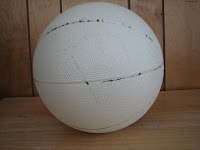Start with a large ball (playground ball, basketball, etc.) Use masking tape to mark the 'equator' around the ball. Paint one half of the ball white and the other half black.

For the demonstration:
Show the students the moon - explain that the sun shines on the moon, as it does the Earth, so that one half the moon is receiving light (the white side of the moon model) and the other half of the moon is in the dark (the black side of the moon model).
Then lay out the scenario:
The students, at their desks, are residing on the Earth.
The chalkboard/whiteboard at the front of the room is the sun (you could even draw a picture of the sun, if you wished).
The moon travels around the Earth, so you will carry the ball around the classroom, in a large circle that encompasses all of the students.
Remember.... the white side of the moon model always needs to face the sun!
Begin at the front of the classroom. Hold the moon so the white side is facing the sun. When the students, on Earth, look at the moon, they should only see the black side - this is the arrangement of the Earth, sun, and moon when there is a new moon.

Move to the back of the classroom. Hold the mood so the white side is facing the sun. When the students, on Earth, look at the moon, they should only see the white side - this is the arrangement of the Earth, sun, and moon when there is a full moon.

You can then move to the sides of the classroom, stopping at various points so students can see varying amounts of white and black, illustrating waxing and waning, crescents and gibbous moons, first quarter moon and third quarter moon.

You may wish to have students draw sketches of what they see as the moon circles the Earth.





This is such a great activity! I'm planning a round-up of Moon-related activities and ideas on my blog this coming Monday (11/24/14) and will be featuring a link to your blog post. I'd love to feature the photo too. Please let me know if I have your permission. Thanks!
ReplyDelete